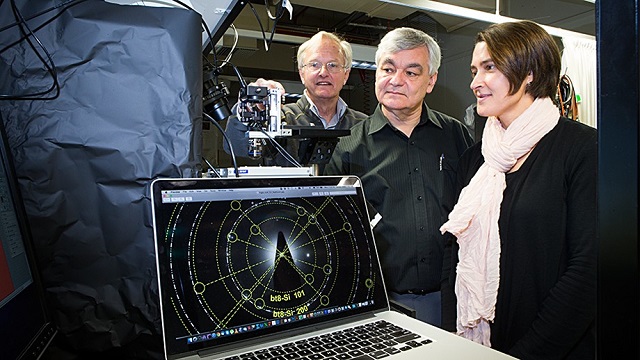 Professor Jim Williams (L), Professor Andrei Rode and Associate Professor Jodie Bradby with the electron diffraction pattern of one of their new silicon phases. Image: Stuart Hay, ANU
Professor Jim Williams (L), Professor Andrei Rode and Associate Professor Jodie Bradby with the electron diffraction pattern of one of their new silicon phases. Image: Stuart Hay, ANU
A team of researchers has developed a novel technique to make new, exotic materials using ultra-short laser-induced micro-explosions in silicon.
Micro-explosions produce high pressure around the site of explosion, forming new phases. However, these phases are characterized by complicated structures, which took the research group from the University College London and The Australian National University (ANU) a year to decipher.
According to Professor Andrei Rode, who led the research and serves as a laser physicist at the ANU Research School of Physics and Engineering (RSPE), the latest method could help in the design and development of high-efficiency light sensors, solar cells, and superconductors.
We've created two entirely new crystal arrangements, or phases, in silicon and seen indications of potentially four more. Theory predicts these materials could have very interesting electronic properties, such as an altered band gap, and possibly superconductivity if properly doped.
Professor Rode, laser physicist at the ANU Research School of Physics and Engineering (RSPE)
Professor Jim Williams from the Electronic Material Engineering group at RSPE informed that the researchers used a combination of structure predictions and electron diffraction patterns and observed that the novel materials exhibited complex crystal structures, which recur every 12, 16 or 32 atoms, in that order.
The micro-explosions change silicon's simplicity to much more complex structures, which opens up possibility for unusual and unexpected properties. These new discoveries are not an accident, they are guided by a deep understanding of how lasers interact with matter, said Professor Williams
Professor Eugene Gamaly, also from the ANU Research School of Physics and Engineering, added that the complicated phases are not usually stable; however, since the structures are small the materials cool rapidly and solidify prior to decomposition. The breakthrough crystal structures have lasted for over a year.
Traditional techniques used for producing high pressure materials use small diamond anvils to squeeze or poke materials, but in contrast, the ultra-short laser micro-explosions generate pressures that are considerably higher than the collective strength produced by a diamond crystal.
Dr Jodie Bradby from ANU Research School of Physics and Engineering added that the latest method paves the way for a more cost-effective and industry-friendly approach for massive production of these exotic materials.
We reliably create thousands of micron-size modified zones in normal silicon within a second. The semiconductor industry is a multi-billion dollar operation - even a small change in the position of a few silicon atoms has the potential to have a major impact, Bradby concluded.
References